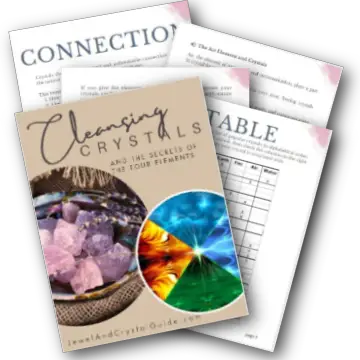
What is fluorite
Fluorite is a crystal made of calcium fluoride. It comes in many different colors, often in the same crystal, depending on what minerals or impurities are in it. Fluorite forms in a cubic (like a box or dice) or octahedral shape (with eight triangular surfaces).

What fluorite is good for
Fluorite is a highly versatile crystal that helps with mental clarity, intuition, and spiritual awareness, while promoting emotional healing, self-love, and personal growth.
Fluorite is also a grounding crystal that stabilizes energy and acts as a protective stone.
Different colors of fluorite bring different benefits. Here’s my in-depth article about the benefits that each color offers.
What to say to fluorite
Holding a fluorite crystal in your hand, closing your eyes, and saying affirmations attracts what you want and need in your life. Fluorite can bring you focus, help you solve problems and make better decisions, ground you, protect you, relieve stress, help you grow spiritually, and more.
Here’s my complete list of affirmations to ask your fluorite crystal for gifts.
Other names for fluorite
The most common other name for fluorite is fluorspar, which is used in the mining industry.
Some varieties of fluorite have more specific names based on their color or where they come from, like “emerald fluorite” or “Mexican fluorite.”
In the UK, banded fluorite from Derbyshire is called Blue John Stone.
Colors of fluorite
Fluorite comes in many colors, including:
- Clear or colorless
- Purple
- Lilac
- Pink
- Blue
- Green
- Yellow or golden
- Brown
- Black
- Rainbow (different colors in one crystal)
Most fluorite is purple, and it’s often mistaken for amethyst. Blue and yellow fluorite are rare, but black, pink, and clear fluorite are the rarest of them all.
Click here to find out why fluorite comes in so many different colors.
How to cleanse and charge fluorite
Fluorite can be cleansed and charged in nature, using earth, fire, or wind. Put the crystal in healthy soil, the smoke of a burning smudge or incense stick, or your own breath to purify and revitalize it.
But don’t use water to cleanse or charge fluorite crystal…
Fluorite cannot go in water or saltwater as it’s a soft crystal and can be damaged by water and salt exposure. If you need to clean fluorite, wipe it with a damp cloth or rinse it in clean water for no more than a few seconds.
Here’s a list with instructions on all the ways to safely cleanse and charge fluorite crystals.
Fluorite versus other crystals
Fluorite versus quartz
Fluorite is not the same as quartz, even though they can look similar. Fluorite is a softer halide mineral that comes in a wider range of colors, but is usually purple. Quartz is a hard silicate mineral that’s usually clear or white, but does come in color.

Fluorite versus amethyst
Purple fluorite and amethyst are not the same crystal and are not related to each other. Amethyst is purple quartz and fluorite is halide.
But this is only the beginning – to get all the differences between amethyst and purple fluorite, you can read this article that I put together.
Fluorite versus calcite
Fluorite and calcite are different crystals. Fluorite is a semi-precious halide crystal that’s made up of calcium and fluorine. Calcite, on the other hand, is a common calcium carbonate crystal that’s made up of calcium, carbon, and oxygen.
For a more detailed comparison of the differences between these minerals with examples, check out this blog post.
Fluorite versus aventurine
Fluorite is not the same as aventurine. Fluorite is a dull halide that comes in many colors, usually purple. Aventurine is quartz that’s usually green or brown, sometimes blue or red, and sparkles.
Is fluorite expensive?
The cost of fluorite depends on the quality, color, and size of the crystal, as well as how many people want to buy it and how many crystals are available.
A medium-quality fluorite crystal costs about $1 to $10 per carat. Fluorite is not as expensive as some other gemstones, like emeralds, but very-high-quality fluorite is still quite valuable at over $50 per carat.
Here is a table with the average price ranges of fluorite per carat:
| Quality | Price Range (USD) |
| Low quality | <$1 per carat |
| Medium quality | $1-$10 per carat |
| High quality | $10-$50 per carat |
| Exceptional quality | $50+ per carat |
Where to keep fluorite crystal
Some great places to keep fluorite are in jewelry, in the living room, in a bedroom, and in the car. Different colors bring different gifts, so be sure to choose the right fluorite color for what you need.
Click here to get all my ideas on where to keep your fluorite and why.
How to tell if fluorite is real
All crystals can be measured on the Mohs scale to determine how hard or soft the crystal is.
Fluorite is a 4 out of 10 on the Mohs scale, which is quite low.
This gives us one easy way to tell if a fluorite crystal is real or not:
If the crystal cannot be scratched by a copper penny (3.5 on the Mohs scale, so softer) but can be scratched with a knife (5.5 on the Mohs scale, so harder), it’s likely to be fluorite and not a fake.
Click here for a list of ways to tell if fluorite is real or not.
Who should wear fluorite
While anyone can wear fluorite, Pisces, Gemini, Capricorn, and Aries are believed to benefit most from this crystal due to their astrological properties.
Fluorite is not one of the traditional birthstones, but it is strongly associated with Pisces and sometimes used as an alternative birthstone for Aries.
Read More: Why your sign should wear fluorite











